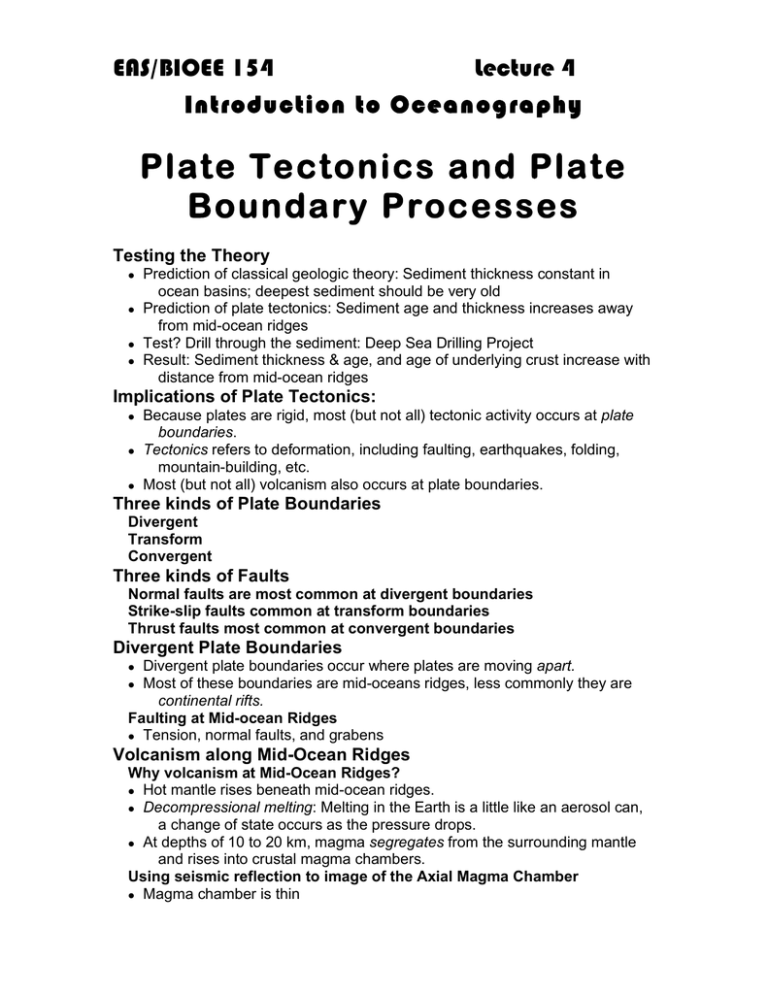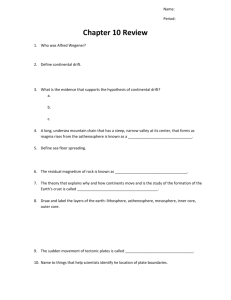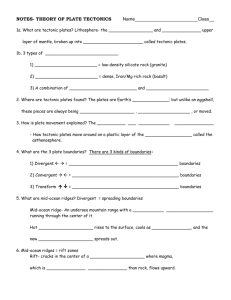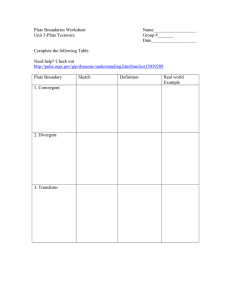Plate Tectonics - Cornell Geological Sciences
advertisement

EAS/BIOEE 154 Lecture 4 Introduction to Oceanography Plate Tectonics and Plate Boundary Processes Testing the Theory Prediction of classical geologic theory: Sediment thickness constant in ocean basins; deepest sediment should be very old Prediction of plate tectonics: Sediment age and thickness increases away from mid-ocean ridges Test? Drill through the sediment: Deep Sea Drilling Project Result: Sediment thickness & age, and age of underlying crust increase with distance from mid-ocean ridges Implications of Plate Tectonics: Because plates are rigid, most (but not all) tectonic activity occurs at plate boundaries. Tectonics refers to deformation, including faulting, earthquakes, folding, mountain-building, etc. Most (but not all) volcanism also occurs at plate boundaries. Three kinds of Plate Boundaries Divergent Transform Convergent Three kinds of Faults Normal faults are most common at divergent boundaries Strike-slip faults common at transform boundaries Thrust faults most common at convergent boundaries Divergent Plate Boundaries Divergent plate boundaries occur where plates are moving apart. Most of these boundaries are mid-oceans ridges, less commonly they are continental rifts. Faulting at Mid-ocean Ridges Tension, normal faults, and grabens Volcanism along Mid-Ocean Ridges Why volcanism at Mid-Ocean Ridges? Hot mantle rises beneath mid-ocean ridges. Decompressional melting: Melting in the Earth is a little like an aerosol can, a change of state occurs as the pressure drops. At depths of 10 to 20 km, magma segregates from the surrounding mantle and rises into crustal magma chambers. Using seismic reflection to image of the Axial Magma Chamber Magma chamber is thin EAS/BIOEE 154 Lecture 4 perhaps 100 m deep 1 to 2 km wide Better called a magma lens Magma lens underlain by thick mush zone Continuous along much of the EPR Mid-Ocean Ridge Hydrothermal Activity Hydrothermal Activity results from the interaction of water (seawater) and hot rock. Black Smokers Minerals dissolved in fluid precipitate when water mixes with cold seawater these precipitates look like smoke. Hydrothermal Vent Communities Ridges vs Rises The difference is spreading rate. Transform Plate Boundaries Transform Plate Boundaries occur where 2 plates slide past one and other. Characterized by strike-slip faulting; earthquakes common Examples: San Andreas Fault Alpine Fault, NZ Fracture zones on mid-ocean ridges Plate Rotations All motions on the surface of a sphere are rotations Plate motion is described in terms of a pole and rotation vector. Motion between plates will change along the boundary. Convergent Plate Boundaries & Subduction Convergent plate boundaries occur where plates are moving toward one and other. Usually, one plate slides under the other in a process called subduction. Subduction Zones characterized by: Deep oceanic trench (but sometimes filled with sediment) Chain of volcanoes: Subduction-related volcanoes are particularly explosive and dangerous because they are rich in H2O – derived from subducting oceanic crust When they occur in the oceans, these are called an “island arc”. Thrust faulting; large earthquakes common Continental collisions Two continental plates collide, neither wants to go down Mountain-building is a common result. E.g., India-Asia collision; Himalayas EAS/BIOEE 154 Lecture 4 Some Study Questions How did the Deep Sea Drilling Project test the plate tectonic hypothesis? What was the outcome? Explain the three types of plate boundaries. Give an example of a geographic feature related to each. Explain the difference between normal, strike-slip, and thrust faults. Which occurs most commonly at divergent plate boundaries? Which is most likely to generate a tsunami? Using the concept of decompression melting, explain why midocean ridges are volcanically active? What are the typical dimensions of magma chambers beneath mid-ocean ridges? Why does hydrothermal activity occur at mid-ocean ridges? How and why does it differ from hydrothermal activity on land (e.g., Yellowstone)? What kind of faults are most commonly found on transform plate boundaries – explain the motion on these faults. Give an example of a geographic feature associated with a transform plate boundary. What kind of faults are most common at convergent plate boundaries? Explain why volcanism occurs at convergent plate boundaries? Why is this volcanism so explosive – and how does it relate to hydrothermal activity at mid-ocean ridges?






